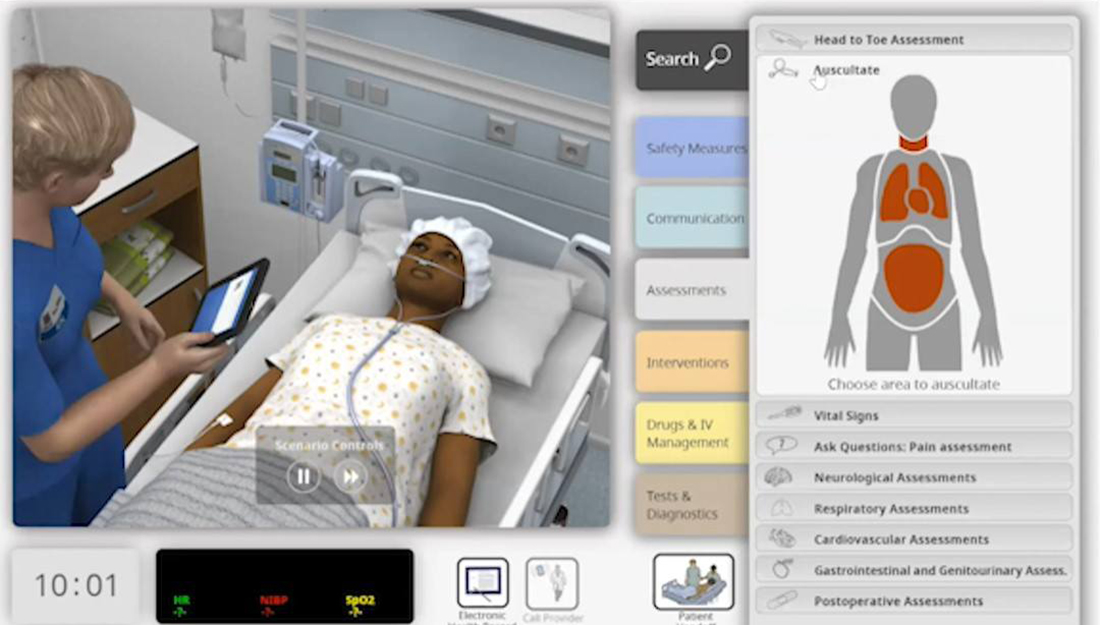- Lindsey Hendrix
- COVID-19, Nursing, Show on VR homepage, Trending
Nursing students using virtual simulations for patient care experiences
The College of Nursing is adapting to COVID-19 by implementing an online alternative to assess students' clinical skills needed to graduate

College of Nursing students are now using online virtual simulations to assess their clinical skills. Provided by Wolters Kluwer, Health
A digital patient named Doris is lying in a hospital bed, recovering from a hysterectomy. A nurse enters the room and introduces herself before walking to the sink and washing her hands.
Clinical Assistant Professor Angela Mulcahy clicks a button indicating that the nurse on her computer screen should take the patient’s blood pressure and listen to her breathing with a stethoscope. Demonstrating an example of the kind clinical experiences students in Texas A&M University’s College of Nursing are now completing, Mulcahy said they’re the same steps students normally complete with their patients in clinics or hospitals.
The only difference, Mulcahy said, is that it’s a simulated interaction happening through a computer program.
Under normal circumstances, Texas A&M nursing students complete their clinical rotations at local clinics and hospitals. This has been suspended as facilities across the state grapple with the COVID-19 pandemic.
In response, Gov. Greg Abbott recently waived limits on the number of clinical hours that can be completed in a simulated care setting to help nursing students meet their clinical competency requirements needed to graduate. Also as a means to get more health care professionals into the workforce, the state is allowing temporary permit extensions to graduate and vocational nurses who haven’t yet taken the licensing exam.
The College of Nursing seized on those changes to help answer the call for more medical workers: second-semester seniors can opt to fast-track their graduation plan, and virtual patient simulations are being used for the first time so prelicensure students can complete the clinical education hours needed to graduate.
“Because our clinical sites located in health care systems are moving very quickly to respond to preparation for the pandemic, what that has meant for us is coming up with alternative solutions for clinical experiences has had to move really quickly,” said College of Nursing Dean Nancy Fahrenwald. “Our faculty identified a virtual simulation experience that allowed us to assess competency of our students clinically as well as to achieve our final program objectives so that we can determine whether these May 2020 pre-licensure BSN [Bachelor of Science in Nursing] graduates are prepared to enter into the workforce.”
Like the rest of the college’s classes, simulations have had to move online as a result of the current public health crisis. The college routinely uses simulated scenarios with human patients, but faculty and staff had to move quickly to implement the virtual simulations – students began using them last week.
Mulcahy serves as the prelicensure program coordinator and simulation lead for the College of Nursing.
“Given the current circumstances with clinical settings limiting student experiences as they respond to COVID-19, it became necessary for us to find another way to meet those clinical objectives,” Mulcahy said.
Depending on the course, students are expected to complete a set number of hours in a clinical setting to demonstrate that they can thoroughly assess a patient, prioritize problems and come up with an appropriate plan of care. Mulcahy said this might mean working 12-hour days for about 10 days in a clinical or surgical unit.
Mulcahy said the simulations are surprisingly realistic compared to what a student would encounter in a hospital.
The virtual simulations effectively look the same: students enter a patient’s room, identify themselves, wash their hands and click through a menu of questions to ask. Mulcahy says the objective remains the same – to make assessments and work with the health care team to care for a patient.
“Unlike doing it with their actual hands at the bedside or in the simulation lab, they’re clicking on buttons,” she said. “But they’re still having to think through each step of the process and actually identify each step in the right order before they’re able to essentially move on.”
Faculty members assign patient simulations to their students, and can see a time log of what actions were taken, in what order and how long it took the student to take them. It’s a useful tool that Mulcahy hopes to use in her classes even after the coronavirus crisis subsides.
“Having that document I see being an incredible asset to myself as faculty to augment what we’re already doing clinically,” Mulcahy said.
Faculty have adjusted and adapted quickly to the technology, she said, and so far the feedback from students has been very favorable.
“I was really kind of holding my breath, not sure how they would feel about the scenarios, but a lot of things that I’ve seen in the reflections and student comments are exactly what I would hope to see in a clinical setting,” Mulcahy said. “They’re saying, ‘Hey, I needed to prioritize better, I needed to review this.’”
Faculty will continue to monitor how best to implement the virtual simulations to ensure students meet their needed clinical objectives.
Established in 2008, the College of Nursing has a 100 percent job placement rate for BSN students within one year of graduation.
This article by Caitlin Clark originally appeared in Texas A&M Today.
Media contact: media@tamu.edu


